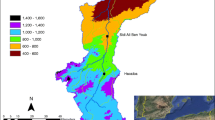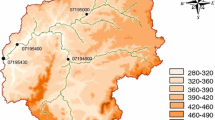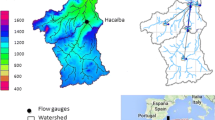Abstract
Parameter uncertainty in hydrologic modeling is crucial to the flood simulation and forecasting. The Bayesian approach allows one to estimate parameters according to prior expert knowledge as well as observational data about model parameter values. This study assesses the performance of two popular uncertainty analysis (UA) techniques, i.e., generalized likelihood uncertainty estimation (GLUE) and Bayesian method implemented with the Markov chain Monte Carlo sampling algorithm, in evaluating model parameter uncertainty in flood simulations. These two methods were applied to the semi-distributed Topographic hydrologic model (TOPMODEL) that includes five parameters. A case study was carried out for a small humid catchment in the southeastern China. The performance assessment of the GLUE and Bayesian methods were conducted with advanced tools suited for probabilistic simulations of continuous variables such as streamflow. Graphical tools and scalar metrics were used to test several attributes of the simulation quality of selected flood events: deterministic accuracy and the accuracy of 95 % prediction probability uncertainty band (95PPU). Sensitivity analysis was conducted to identify sensitive parameters that largely affect the model output results. Subsequently, the GLUE and Bayesian methods were used to analyze the uncertainty of sensitive parameters and further to produce their posterior distributions. Based on their posterior parameter samples, TOPMODEL’s simulations and the corresponding UA results were conducted. Results show that the form of exponential decline in conductivity and the overland flow routing velocity were sensitive parameters in TOPMODEL in our case. Small changes in these two parameters would lead to large differences in flood simulation results. Results also suggest that, for both UA techniques, most of streamflow observations were bracketed by 95PPU with the containing ratio value larger than 80 %. In comparison, GLUE gave narrower prediction uncertainty bands than the Bayesian method. It was found that the mode estimates of parameter posterior distributions are suitable to result in better performance of deterministic outputs than the 50 % percentiles for both the GLUE and Bayesian analyses. In addition, the simulation results calibrated with Rosenbrock optimization algorithm show a better agreement with the observations than the UA’s 50 % percentiles but slightly worse than the hydrographs from the mode estimates. The results clearly emphasize the importance of using model uncertainty diagnostic approaches in flood simulations.










Similar content being viewed by others
References
Bates BC, Campbell EP (2001) A Markov chain Monte Carlo scheme for parameter estimation and inference in conceptual rainfall-runoff modeling. Water Resour Res 37(4):937–947
Beven KJ (1993) Prophecy, reality and uncertainty in distributed hydrological modeling. Adv Water Resour 16:41–51
Beven K (2008) Environmental modelling: an uncertain future?. Taylor & Francis Ltd, London
Beven K, Binley A (1992a) The future of distributed models: model calibration and uncertainty prediction. Hydrol Process 6:279–298
Beven KJ, Binley AM (1992b) The future of distributed models: model calibration and uncertainty prediction. Hydrol Process 6(3):272–298
Beven K, Binley A (2014) GLUE: 20 years on. Hydrol Process 28:5897–5918
Beven KJ, Kirkby MJ (1979) A physically based, variable contributing area model of basin hydrology. Hydrol Sci Bull 24:43–69
Beven K, Smith PJ, Freer J (2008) So just why would a modeller choose to be incoherent? J Hydrol 354:15–32
Blasone R-S, Madsen H, Rosbjerg D (2008) Uncertainty assessment of integrated distributed hydrological models using GLUE with Markov chain Monte Carlo sampling. J Hydrol 353:18–32
Chen J, Wu Y (2012) Advancing representation of hydrologic processes in the soil and water assessment tool (SWAT) through integration of the TOPographic MODEL (TOPMODEL) features. J Hydrol 420–421:319–328
Duan Q, Sorooshian S, Gupa VK (1992) Effective and efficient global optimization for conceptual rainfall-runoff models. Water Resour Res 28(4):265–284
Freer JE, Beven KJ (2001) Equifinality, data assimilation, and uncertainty estimation in mechanistic modelling of complex environmental systems using the GLUE methodology. J Hydrol 249(1–4):11–29
Gelman A, Rubin DB (1992) Inference from iterative simulation using multiple sequences. Stat Sci 7(4):457–472
Haario H, Saksman E, Tamminem J (2001) An adaptive Metropolis algorithm. Bernoulli 7(2):223–242
Hastings WK (1970) Monte Carlo sampling methods using Markov chains and their applications. Biometrika 57:97–109
Hornberger GM, Spear RC (1981) An approach to the preliminary analysis of environmental systems. J Environ Manag 12:7–18
Kavetski D, Kuczra G, Franks SW (2006) Bayesian analysis of input uncertainty in hydrological modeling:1. Theory. Water Resour Res 42:W03407. doi:10.1029/2005WR004368
Kuczera G, Parent E (1998) Monte Carlo assessment of parameter uncertainty in conceptual catchment models—the Metropolis algorithm. J Hydrol 211:69–85
Li B, Yu Z, Liang Z, Acharya K (2014a) Hydrologic response of a high altitude glacierized basin in the central Tibetan Plateau. Glob Planet Change 118:69–84
Li B, Yu Z, Liang Z, Song K, Li H, Wang Y, Zhang W, Acharya K (2014b) Effects of climate variations and human activities on runoff in the Zoige alpine wetland in the eastern edge of the Tibetan Plateau. J Hydrol Eng 19(5):1026–1035
Liang Z, Li B, Yu Z, Hua J, Liu J (2009) Parametric uncertainty analysis for TOPMODEL based on Bayesian theory. J Hohai Univ (Nat Sci) 37(2):129–132
Liang Z, Chang W, Li B (2012) Bayesian flood frequency analysis in the light of model and parameter uncertainties. Stoch Environ Res Risk Assess 26(5):721–730
Mantovan P, Todini E (2006) Hydrological forecasting uncertainty assessment: incoherence of the GLUE methodology. J Hydrol 330:368–381
Marshall L, Nott D, Sharma A (2004) A comparative study of Markov chain Monte Carlo methods for conceptual rainfall-runoff modeling. Water Resour Res 40:W02501
Metropolis N, Rosenbluth AW, Rosenbluth MN, Teller AH, Teller E (1953) Equation of state calculations by fast computing machines. J Chem Phys 21(6):1087–1092
Montanari A (2005) Large sample behaviors of the generalized likelihood uncertainty estimation (GLUE) in assessing the uncertainty of rainfall-runoff simulations. Water Resour Res 41:W08406
Muleta MK, Nicklow JW (2005) Sensitivity and uncertainty analysis coupled with automatic calibration for a distribution watershed model. J Hydrol 306:127–145
Renard B, Kochanek K, Lang M, Garavaglia F, Paquet E, Neppel L, Najib K, Carreau J, Arnaud P, Aubert Y (2013) Data-based comparison of frequency analysis methods: a general framework. Water Resour Res 49(2):825–843
Reusser DE, Zehe E (2011) Inferring model structural deficits by analyzing temporal dynamics of model performance and parameter sensitivity. Water Resour Res 47:W07550
Rosenbrock HH (1960) An automatic method for finding the greatest or least value of a function. Comput J 3:175–184
Shafii M, Tolson B, Matott LS (2014) Uncertainty-based multi-criteria calibration of rainfall-runoff models: a comparative study. Stoch Environ Res Risk Assess 28(6):1493–1510
Smith AFM, Robert GO (1993) Bayesian computation via the Gibbs sampler and related Markov chain Monte Carlo methods. J R Stat Soc Ser B 55:3–23
Spear RC, Grieb TM, Shang N (1994) Parameter uncertainty and interaction in complex environmental models. Water Resour Res 30:3159–3170
Vrugt JA, Ter Braak CJF, Clark MP, Hyman JM Robinson BA (2008) Treatment of input uncertainty in hydrologic modeling: doing hydrology backward with Markov chain Monte Carlo simulation. Water Resour Res 44:W00B09
Vrugt JA, ter Braak CJF, Gupta HV, Robinson BA (2009) Equifinality of formal (DREAM) and informal (GLUE) Bayesian approaches in hydrologic modeling? Stoch Environ Res Risk Assess 23(7):1011–1026
Yan Y, Tao X, Li B, Mazzetti C (2009) Application of hydrometeorological coupled European flood forecasting operational real time system in Yellow River Basin. Water Sci Eng 2(4):28–39
Yao C (2007) Development and application of grid-based distributed Xinanjiang model, MSc Dissertation, Hohai University, Nanjing, China
Yatheendradas S, Wagener T, Gupta H, Unkrich C, Goodrich D, Schaffner M Stewart A (2008) Understanding uncertainty in distributed flash flood forecasting for semiarid regions. Water Resour Res 44(5):W05S19
Ye Y (2007) Study on runoff-yield model based on statistic theory, MSc Dissertation, Hohai University, Nanjing, China
Acknowledgments
This work was supported by the National Key R&D Program of China (Nos. 2016YFC0402706, 2016YFC0402707, 2016YFC0402709), National Natural Science Foundation of China (No. 51509067), Special Fund for Public Welfare Industry of the Ministry of Water Resources of China (No. 201501004), the Fundamental Research Funds for the Central Universities of China (No. 2015B00114) and the Project Funded by China Postdoctoral Science Foundation (No. 2015M580450). We would like to thank Zhongbo Yu, Jiapeng Hua and Jintao Liu for their comments on MCMC implementation, Qingbo Cheng for his constructive suggestions and Keith Beven (Lancaster University) for providing the program code of HSY GSA and GLUE at http://www.uncertain-future.org.uk. We also thank the anonymous reviewers as their comments have largely improved this work.
Author information
Authors and Affiliations
Corresponding author
Rights and permissions
About this article
Cite this article
Li, B., Liang, Z., He, Y. et al. Comparison of parameter uncertainty analysis techniques for a TOPMODEL application. Stoch Environ Res Risk Assess 31, 1045–1059 (2017). https://doi.org/10.1007/s00477-016-1319-2
Published:
Issue Date:
DOI: https://doi.org/10.1007/s00477-016-1319-2




